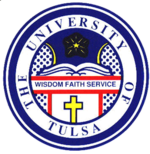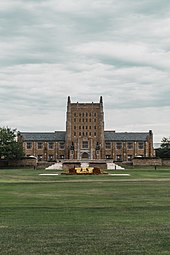
Tulsa is the second-most-populous city in the state of Oklahoma, after Oklahoma City, and is the 47th-most-populous city in the United States. The population was 413,066 as of the 2020 census. It is the principal municipality of the Tulsa metropolitan area, a region with 1,034,123 residents. The city serves as the county seat of Tulsa County, the most densely populated county in Oklahoma, with urban development extending into Osage, Rogers and Wagoner counties.
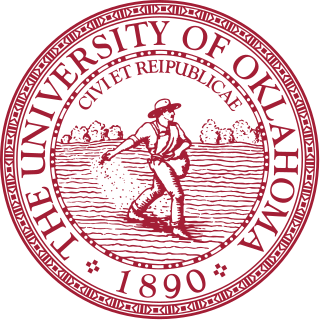
The University of Oklahoma (OU) is a public research university in Norman, Oklahoma, United States. Founded in 1890, it had existed in Oklahoma Territory near Indian Territory for 17 years before the two territories became the state of Oklahoma. In Fall 2023, the university had 32,676 students enrolled, most at its main campus in Norman. Employing nearly 4,000 faculty members, the university offers 174 baccalaureate programs, 199 master's programs, 101 doctoral programs, and 88 certificate programs.

Skelly Field at H. A. Chapman Stadium is an outdoor college football stadium in the south central United States, located on the campus of the University of Tulsa in Tulsa, Oklahoma. Commonly known as H. A. Chapman Stadium, it is the home field for the Tulsa Golden Hurricane of the American Athletic Conference.
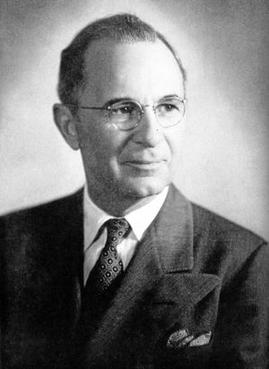
William Thomas Gilcrease was an American oilman, art collector, and philanthropist. During his lifetime, Gilcrease collected more than 10,000 artworks, 250,000 Native American artifacts and 100,000 rare books and documents, including the only surviving certified copy of the Declaration of Independence. He was the founder of Gilcrease Museum in Tulsa, Oklahoma. In 1971, he was inducted into the Hall of Great Westerners of the National Cowboy & Western Heritage Museum.

Alice Mary Robertson was an American educator, social worker, Native Americans' rights activist, government official, and politician who became the second woman to serve in the United States Congress, and the first from the state of Oklahoma. Robertson was the first woman to defeat an incumbent congressman. She was known for her strong personality, commitment to Native American issues, and anti-feminist stance.
The title of "Oil Capital of the World" is often used to refer to Tulsa, Oklahoma. Houston, Texas, the current center of the oil industry, more frequently uses the sobriquet “The Energy Capital of the World.”
Steadman Upham was an American archaeologist and university administrator who served as president of Claremont Graduate University from 1998 to 2004 and the University of Tulsa (TU) from 2004 to 2016. Prior to this time, he was vice provost for research and dean of the Graduate School and professor of archaeology at the University of Oregon. Many of the students at TU fondly called him, "Uncle Stead." Upham was a widely published archaeologist, having written or edited 10 books and more than 75 book chapters and journal articles. He lectured extensively in the United States and Canada. While at TU, he held a concurrent appointment as professor in the Department of Anthropology.
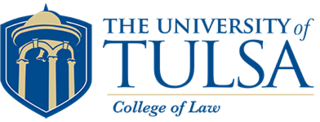
The University of Tulsa College of Law is the law school of the private University of Tulsa in Tulsa, Oklahoma. For 2023, U.S. News & World Report ranked the University of Tulsa College of Law at No. 111 among all law schools in the United States. It is the only law school in the Tulsa Metropolitan Area and northeastern Oklahoma.
Robert M. McFarlin was an American oilman, cattle rancher, philanthropist, and businessman who is best known for amassing a fortune by drilling for oil near Glenpool, Oklahoma, with his nephew and son-in-law, James A. Chapman. He was among the early pioneer oilmen who established the state of Oklahoma as a center of the oil industry in the early part of the 20th century.
Arthur Grant Evans was the third president of University of Tulsa and then the second president of the University of Oklahoma. Born to English parents in India, and educated in London, he emigrated to North America in 1883 and lived briefly in Canada.

Bacone College, formerly Bacone Indian University, is a private college in Muskogee, Oklahoma. Founded in 1880 as the Indian University by missionary Almon C. Bacone, it was originally affiliated with the mission arm of what is now American Baptist Churches USA. Renamed as Bacone College in the early 20th century, it is the oldest continuously operated institution of higher education in Oklahoma. The liberal arts college has had strong historic ties to several tribal nations, including the Muscogee and Cherokee. The Bacone College Historic District has been on the National Register of Historic Places listings in Muskogee County, Oklahoma since 2014.
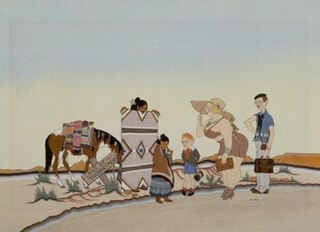
Woodrow Wilson Crumbo (Potawatomi) was an artist, Native American flute player, and dancer who lived and worked mostly in the West of the United States. A transcript of his daughter's interview shows that Mr. Crumbo was born on January 31, 1912, so there is a discrepancy of the date until confirmation. As an independent prospector in New Mexico in the late 1950s, he found one of the largest beryllium veins in the nation, valued at millions of dollars.

The Tulsa Golden Hurricane men's basketball team represents the University of Tulsa in Tulsa, in the U.S. state of Oklahoma. The team participates in the American Athletic Conference. The Golden Hurricane are led by head coach Eric Konkol, hired from Louisiana Tech on March 21, 2022 to replace Frank Haith who had resigned.

The Tulsa metropolitan area, officially defined as the Tulsa metropolitan statistical area is a metropolis in northeastern Oklahoma centered around the city of Tulsa and encompassing Tulsa, Rogers, Wagoner, Osage, Creek, Okmulgee and Pawnee counties. It had a population of 1,034,123 according to the 2022 U.S. census estimates.

The Tulsa Golden Hurricane football program represents the University of Tulsa in college football at the NCAA Division I Football Bowl Subdivision (FBS) level. Tulsa has competed in the American Athletic Conference since the 2014 season and was previously a member of Conference USA (C-USA). The team is led by head coach Kevin Wilson. Tulsa plays its home games at Skelly Field at H. A. Chapman Stadium in Tulsa, Oklahoma. The University of Tulsa has the smallest undergraduate enrollment of all schools that participate at the FBS level.
Alexandre Hogue was an American artist active from the 1930s through the 1980s. He was a realist painter associated with the Dallas Nine; the majority of his works focus on Southwestern United States and South Central United States landscapes during the Dust Bowl.
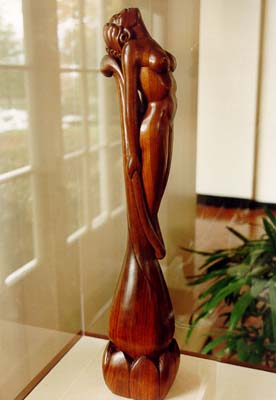
Willard Stone was an American artist best known for his wood sculptures carved in a flowing Art Deco style.
Ben Graf Henneke was the president of the University of Tulsa ("TU"), in Tulsa, Oklahoma, United States, from 1958 to 1967. A professor of speech and theatre, he wrote an early textbook on radio announcing, and was instrumental in the creation of the university's radio station, KWGS. Henneke also wrote the TU fight song when he was an undergraduate student at the school. Henneke has been cited as one of the most influential figures in the university's history.
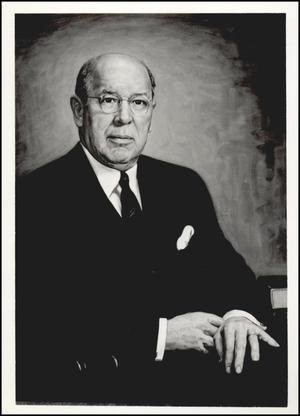
William Grove Skelly was an entrepreneur who made a fortune in the oil business. Born in Erie, Pennsylvania, he moved to Kansas in 1916, then to Tulsa, Oklahoma, in 1919, where he founded Skelly Oil Company. By 1923, his company was one of the strongest independent producers of oil and gasoline in the United States. He helped organize the first International Petroleum Exposition in Tulsa in 1923 and became president of that organization, a position he held for the rest of his life. He was a founder of the Kansas-Oklahoma branch of the United States Oil and Gas Association, then known as Mid-Continent Oil and Gas Association.
The following is a timeline of the history of the city of Tulsa, Oklahoma, United States.
